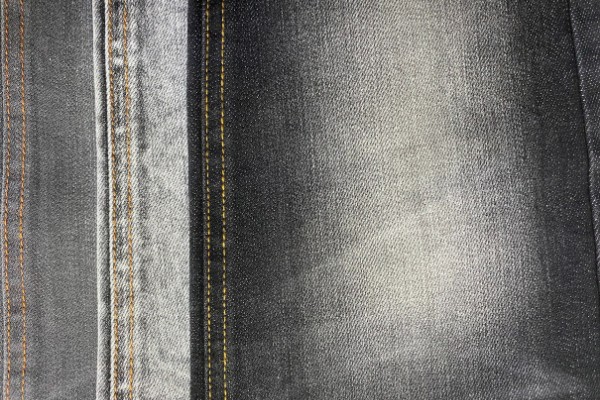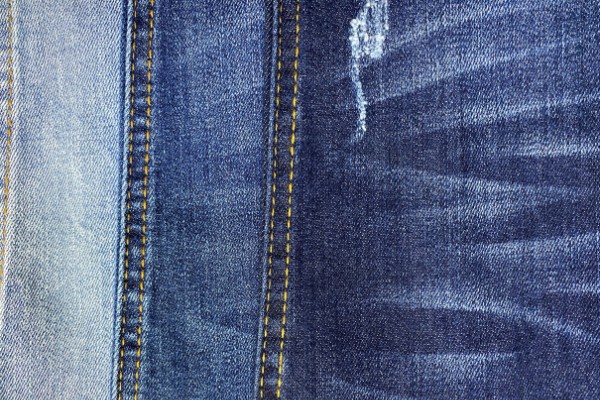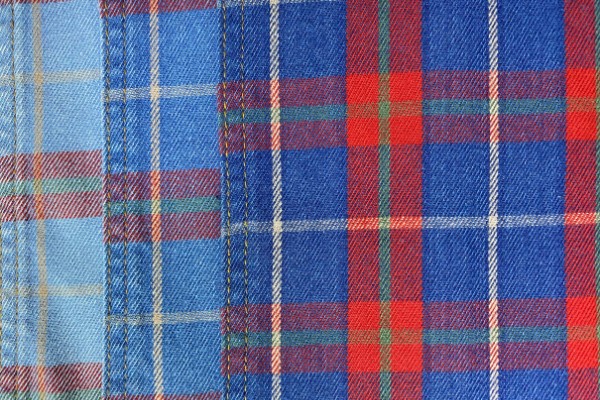Between Different Types Of Denim Fabrics
Denim is a garment that can be worn all year round. How to distinguish between different types of denim (denim): Firstly, according to the thickness of denim, it is divided into 4.5 amps, 6 amps, 8 amps, 10 amps, 11 amps, 12 amps, 13.5 amps, 14.5 amps, etc. 4.5 amps are fragile and are commonly used in summer for women's vests, sleeveless garments, etc. 14.5 amps are already very thick. In winter, men's cotton jackets can be lined with cotton.Most of the jeans we often wear start at 8-12 A.
In terms of the type of denim fabric, it can be divided into plain, twill, herringbone, interwoven, bamboo, dark, flocked, etc.
In terms of composition, denim is available in 100 percent cotton, stretch (Lycra), cotton and linen blends, and tencel.
At present, the famous denim varieties at home and abroad are mainly Yuan Bao silk denim, warp, and weft bamboo denim, super indigo-dyed denim, jacket color, what color denim, warp, and weft stretch denim, etc.
1. Ring spun yarn denim
With the development and application of new technology equipment such as ring spinning, high speed, large rolls, good contact, knotless yarn, etc., the short length of thick spinning, low production efficiency, knots, and other shortcomings are solved.
The situation of denim yarns being replaced by air-flow yarns is rapidly changing, and ring spinning yarns are making a comeback.
The ring yarn denim has some superior properties to those of air-flow yarns, such as feel, suspension, tear strength, etc., and because of the psychological influence of people returning to nature and pursuing originality in the development of denim styles. This is in line with today's need for individuality in denim.
In addition, the ring spindle can be used to weave short, dense bamboo knots, which is a popular feature of denim.
2. Bamboo denim
The design of bamboo yarns with different yarn grades, different thicknesses (about the baseline), lengths and distances of bamboo joints, in the single warp direction, single weft direction, warp, and weft bi-directional configuration, and with the appropriate design of ordinary yarns of the same or different grades, allows for the production of a wide variety of bamboo denim. Which, after washing and processing, results in a variety of blurred, well-defined stripes.
In the early days, most of the bamboo denim was made from ring-spun bamboo yarn, which was spun in short lengths, with a slight pitch and relatively high density to create a dense decorative effect on the fabric, mainly leading to the bamboo knots.
In line with the evolving consumer demand, warp and weft bi-directional denim are now famous, especially bi-directional denim products with weft elasticity, which are very popular in domestic and international markets.
You can make some grades with a single rate of ring spindle thread and a suitable proportion of bamboo thread in the weft direction, provided that the tissue structure is well designed.
The use of polyurethane elastomeric yarns has led to a new dimension in the development of denim varieties, making denim garments comfortable to wear. With the help of bamboo knots and colors, denim products can be adapted to fashionable and personalized consumer needs, with great potential for development.
At present, elastic denim is mostly weft stretchy, with an elongation of 20-40%. The amount of extension depends on the fabric design. The tighter the weft, the less flexible it is, and the faster the weft to a certain point.
In addition, the problem of weft shrinkage in the finished stretch denim fabric is currently too significant, generally above 10 %, with some cases reaching 20 % or more.
The solution is not to increase the product's elasticity in the product's design, which is generally 20-30% but to maintain a certain tension in the warp and weft against the tissue and increase the pressure in the pre-finishing width of the fabric shrinks considerably. The finished fabric has a low residual shrinkage in the weft.

Super indigo-dyed or unique dark indigo-dyed denim produces garments that are sharpened to give a special effect of rich, bright colors that are very popular with consumers.
Super indigo-dyed denim is characterized by a particularly deep dyeing and excellent colorfastness.
The former means that the amount of indigo dye dyed per unit weight of yarn (in general, % of the dry weight of the thread, referred to as % dyeing depth) is exceptionally high. e.g., typical denim fabric is dyed 1% to 3% deeper by indigo dyeing of the yarn, while super-indigo dyeing depth is more than 4%.
The latter means that super-indigo dyed denim needs to be washed repeatedly for more than 3 hours. However, the color still reaches or exceeds the color depth of everyday dyed denim when it is not passed, and its color is much brighter than relaxed dyed denim.
For blue-dyed denim, the fastness of polishing depends essentially on the degree of transmission of the dye through the threads, not on the fastness to the polishing of the paint itself (blue wet polish fastness is only graded 1), i.e., the better the transmission, the better the fastness to polishing.
In the past, the so-called indigo-dyed fast-wash technique was, in fact, a deliberate attempt to make the indigo dye lighter to the core of the fiber during the yarn dyeing process. The method requires a remarkable degree of core penetration of the paint, resulting in a deep, bright color after the denim polishing process.
The dyeing depth of super-indigo dyed denim products is increased by more than 60 % compared to conventional denim dyeing. The concentration of indigo in the dye solution is doubled to 3-4 g/L, making it possible to obtain deep colors.
This increases the viscosity of the dyeing solution, resulting in poor flow, which affects the ability of the dye to penetrate the cryptic chromophores and reduces the polish fastness of the denim, which does not meet the final depth required for garment production.
As a result, some companies design to increase the dye depth again, increasing the concentration of indigo in the dye solution again, which deteriorates the penetration performance and creates a vicious circle of back and forth, not meeting the requirements of super indigo color.
The higher the concentration of indigo in the dye, the heavier the color's redness, the darker the color, and the lack of super-indigo effect.
For this reason, many manufacturers are now ready to modify their dyeing equipment to solve this problem by increasing the number of dyeing passes.
For example, increasing the number of dyeing passes to 8, or even 10, not only increases the investment costs, the consumption of dyeing materials, the operational difficulties, and the environmental pollution.
An excellent way to solve this contradiction is to reduce the amount of insurance powder and alkali. Especially the control of the amount of alkali so that the pH value of the dyeing solution is stable between 11 and 12, the dyeing rate is the highest, the color is durable, and the dyeing tension of the gauze is reduced appropriately to obtain an excellent super blue diamond dyeing effect.

5. Colour matching denim
Various denim varieties are now prevalent to increase the color and light variations of the indigo denim variety.
For example, indigo over-dyed sulfur black, indigo over-dyed sulfur grass green, sulfur black green, sulfur blue, etc., to meet the personalized needs of the market.
At the same time, denim mills have patented new varieties of denim to increase their competitiveness in the market.
In this regard, we should pay attention to controlling the concentration of the masterbatch as much as possible to prevent excessive spillage of contaminated liquor, which wastes pollutants and expands the pollution of the environment.
There are mainly bromine indigo (commonly known in the market as emerald blue) denim and sulfur black denim, as well as coffee, emerald green, grey, khaki, sulfur blue denim using a combination of sulfur dyes, and a small amount of red, peach, toffee denim dyed with appropriate dyes and reactive dyes, etc. The production volume is small, but the market demand is urgent.
The main problem is that the color light is unstable, the dyeing is poorly valued, and the garment factories are not satisfied. This is related to the small production batch and the large variety of colors. Still, the dyeing and slurry combination machine has difficulties producing any color variety, consumes a lot, costs a lot, and has problems in sewage treatment.
One solution is to design the machine to minimize the number of color combinations using as few as possible two color combinations and no more than three. Or to use other stable dyestuffs instead to adapt to the dyeing line's production characteristics and obtain a long-lasting dyeing result. Or to solve the problem once and for all by using The color weaving plant is ideal for the production of mixed-color denim using a high-capacity yarn dyeing and warping process.
Talk about how to sew denim on a car.
This is the key to designing a denim garment.
Turning threads: mostly 2-minute single-sided, 2-minute single-sided, 2-minute double-sided, generally earthy yellow (and other clashing threads), but also color-coordinated threads; note the color-coordinated threads after washing.
Special technical threads, such as the word thread.
Thicker hand embroidery threads.
Materials:
denim, I-buttons, four-way buttons, studs, cockles, picks, metal zips, etc.
Markings:
these include central markings, size markings, wash markings, markings, side markings, etc.
Denim is the problem of denim shrinkage. The denim factory master is the busiest; ordinary denim also has 2-3% horizontal shrinkage, elastic denim shrinkage reaches more than 10%. Each roll of denim is different, so the denim master's version will never end.
Generally speaking, there is a lot of casual denim, mainly cut on a flat surface, and sizing is significant.
Stretch denim (including Lycra) is tricky; it's mainly used for women's slim-fitting jackets, flattering low-waisted jeans. With the shrinkage of 10% or more, the shape is constantly being adjusted. And the most crucial thing about jeans is that they don't wrinkle at the front; they need to fit snugly. In the last two years, some of the biggest brands have released three-dimensional silhouettes, as we learned with the stand-up cut, with many wrinkles on the knees.

7. The technique of embellishment in denim
The last two years have seen a departure from previous denim trends, not only in terms of variations in washes but also in the techniques used to embellish jeans.
Burr:
the leg of the jeans, the trousers trimmed with scissors, plus remarkable thread embroidery, including computerized embroidery designs.
Hot drill:
this is popular with the Russian market for applique embroidery, hand embroidery, bead embroidery, and technical designs.
Glue printing:
hard to the touch, wash easily, and peels off.
Laser:
burns off all the colors of the cloth to reveal the color of your fabric, and can also be used with wool, faux leather, corduroy, thick knit (fleece, sanitary), and other fabrics.
Many different designs can be made for denim.
Jeans, denim shirts, denim jackets, skirts, coats, etc., are places to express your creativity and talent.